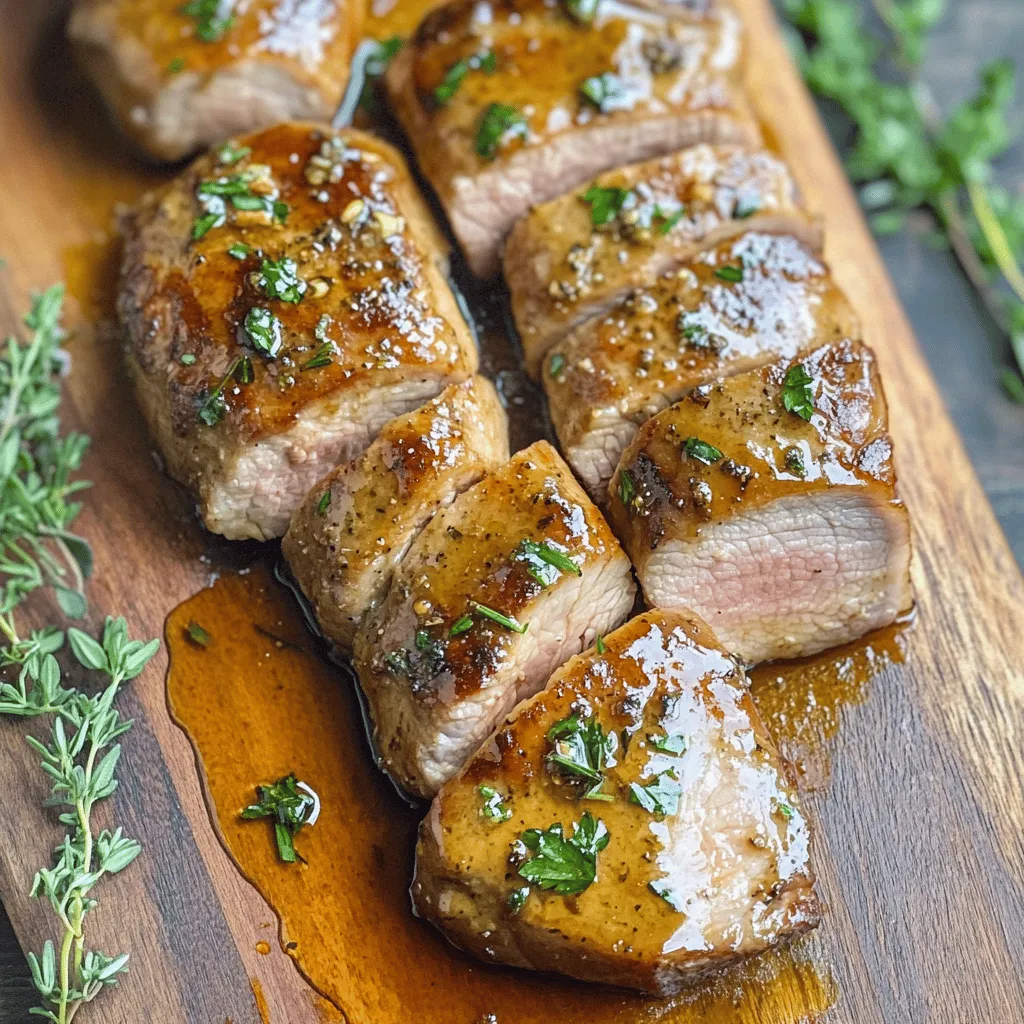Introduction
If you’re looking for a dish that perfectly marries sweet and savory flavors, look no further than Maple Mustard Pork Tenderloin. This recipe elevates the humble pork tenderloin to new culinary heights, making it an ideal choice for both weeknight dinners and special occasions. The luscious combination of rich maple syrup and tangy Dijon mustard creates a glaze that not only enhances the tender meat but also provides a delightful contrast to its natural flavors.
With its impressive presentation and mouthwatering taste, this pork tenderloin is sure to impress your guests at gatherings, holiday feasts, or even a cozy family meal. The best part? It’s surprisingly simple to prepare, allowing you to create a dish that looks and tastes gourmet without spending hours in the kitchen. Let’s dive deeper into this delectable recipe, starting with an understanding of the star of the show: pork tenderloin.
Understanding Pork Tenderloin
Pork tenderloin is a lean and tender cut of meat that comes from the muscle that runs alongside the backbone of the pig. Known for its mild flavor and buttery texture, it’s one of the most sought-after cuts for home cooking. Unlike tougher cuts of pork, the tenderloin cooks quickly and remains juicy when prepared properly.
Nutritional Benefits of Pork Tenderloin
From a nutritional standpoint, pork tenderloin is an excellent choice for health-conscious eaters. It’s low in fat, especially when trimmed of excess fat, and high in protein, making it a fantastic option for those looking to maintain a balanced diet. A typical serving of pork tenderloin provides essential vitamins and minerals, including B vitamins, zinc, and selenium. This makes it not only a delicious choice but also a nutritious one, perfect for fueling an active lifestyle.
Why Pork Tenderloin is Great for Home Cooking
Pork tenderloin is a great choice for home cooking due to its versatility and ease of preparation. It can be roasted, grilled, or pan-seared, and it pairs beautifully with a variety of flavors, from sweet to savory and everything in between. Additionally, it absorbs marinades exceptionally well, making it ideal for recipes like our Maple Mustard Pork Tenderloin, where the marinade plays a crucial role in enhancing the flavor profile. Whether you’re preparing a casual family dinner or a festive spread, pork tenderloin can seamlessly adapt to any culinary theme.
Ingredients Breakdown
For our Maple Mustard Pork Tenderloin, the ingredient list is straightforward yet impactful. Each component contributes to the overall flavor and texture of the dish, ensuring a balanced and delicious result.
Main Ingredients
1. Pork Tenderloin: The star of the dish, the pork tenderloin should be fresh and high-quality. Look for a cut that is firm and pink, with minimal marbling.
2. Maple Syrup: This natural sweetener is the cornerstone of our glaze. The deep, rich flavor of pure maple syrup adds sweetness and complexity, complementing the savory notes of the pork. It caramelizes beautifully during cooking, creating a glossy finish.
3. Dijon Mustard: Known for its tangy and slightly spicy flavor, Dijon mustard adds depth to the marinade. It balances the sweetness of the maple syrup with its sharpness, making each bite exciting and flavorful.
4. Apple Cider Vinegar: This ingredient provides acidity and brightness, cutting through the richness of the pork. It also helps to tenderize the meat, ensuring that every bite is as tender as possible.
5. Fresh Herbs (Rosemary and Thyme): These aromatic herbs infuse the pork with fragrance and flavor. Rosemary contributes a woodsy note, while thyme adds a subtle earthiness, enhancing the overall taste of the dish.
6. Seasoning (Salt and Black Pepper): Simple but essential, salt and black pepper elevate the dish by enhancing the natural flavors of the meat and the marinade.
By understanding the role of each ingredient, you can appreciate how they work together to create a harmonious dish that is both flavorful and satisfying.
Preparing the Marinade
Creating the marinade is a straightforward process that can be done in just a few steps. Here’s how to achieve that perfect balance of flavors for the Maple Mustard Pork Tenderloin:
Step-by-Step Guide on Making the Marinade
1. Gather Your Ingredients: Start by assembling all the ingredients required for the marinade: maple syrup, Dijon mustard, apple cider vinegar, fresh rosemary, fresh thyme, salt, and black pepper.
2. Mix the Base: In a medium-sized bowl, combine the maple syrup, Dijon mustard, and apple cider vinegar. Using a whisk, blend these ingredients until they are thoroughly mixed and form a cohesive marinade.
3. Add the Herbs: Finely chop the fresh rosemary and thyme, then add them to the marinade. Stir well to ensure the herbs are evenly distributed throughout the mixture.
4. Season to Taste: Add salt and black pepper to the marinade according to your preference. Remember that the flavors will concentrate during cooking, so it’s better to start with less and adjust later if needed.
Tips for Achieving a Balanced Flavor in the Marinade
- Taste as You Go: Don’t hesitate to taste the marinade before adding the meat. This will allow you to adjust the levels of sweetness, acidity, and seasoning to your liking.
- Use Quality Ingredients: The quality of the maple syrup and mustard will significantly affect the final flavor of the dish. Opt for pure maple syrup and a good-quality Dijon mustard for the best results.
- Consider Time: The longer you marinate the pork tenderloin, the more pronounced the flavors will be. Aim for at least 30 minutes, but for optimal flavor, marinating for 2-4 hours or even overnight in the refrigerator is recommended.
Importance of Marinating Time for Flavor Penetration
Marinating not only adds flavor but also serves to tenderize the meat. The combination of the acidic apple cider vinegar and the enzymes from the mustard helps break down the proteins in the pork, resulting in a juicier and more flavorful dish. By allowing the pork to soak in the marinade, you ensure that each bite is infused with the delightful combination of maple and mustard.
Marinating the Pork
Now that you have prepared the marinade, it’s time to marinate the pork tenderloin. Here’s how to do it properly:
1. Prepare the Pork: Pat the pork tenderloin dry with paper towels. This helps the marinade adhere better to the meat.
2. Combine with Marinade: Place the pork tenderloin in a resealable plastic bag or a shallow dish. Pour the marinade over the pork, ensuring it is fully coated. If using a bag, seal it tightly and gently massage the marinade into the meat.
3. Refrigerate: Place the marinating pork tenderloin in the refrigerator. As mentioned earlier, aim for a marinating time of at least 30 minutes, but longer is better for depth of flavor.
4. Turn Occasionally: If possible, turn the pork every hour or so to ensure that all sides are evenly marinated.
By following these steps, you set the stage for a mouthwatering Maple Mustard Pork Tenderloin that is sure to become a favorite in your household. In the next section, we will delve into the cooking process to bring this flavorful dish to life.

Detailed Instructions on How to Marinate Properly
Marinating is a crucial step in preparing your Maple Mustard Pork Tenderloin, as it infuses the meat with flavor and enhances its tenderness. Begin by preparing the marinade, which consists of maple syrup, Dijon mustard, soy sauce, garlic, and a touch of black pepper. Once your marinade is ready, place the pork tenderloin in a resealable plastic bag or a shallow baking dish, then pour the marinade over the meat, ensuring it is fully coated.
For optimal marinating, seal the bag tightly, removing as much air as possible to help the marinade penetrate the meat effectively. If using a dish, cover it tightly with plastic wrap. The marinating time can greatly influence the final flavor. Ideally, allow the pork to marinate for at least 1 hour, but for best results, aim for 4 to 6 hours. If you have more time, marinating overnight in the refrigerator will yield even more robust flavor profiles.
Optimal Marinating Times and Methods
When marinating pork tenderloin, consider the cut’s size and thickness. A general rule of thumb is to marinate for:
- 1 hour for a quick flavor infusion,
- 4-6 hours for deeper flavors,
- 12-24 hours for maximum tenderness and taste.
Avoid marinating for more than 24 hours, as the meat can become mushy due to the acidity in the marinade. For the method, refrigeration during marination is essential to prevent bacterial growth. Always discard any leftover marinade that has come into contact with raw meat to avoid cross-contamination.
The Science Behind Marinating and Its Effects on Meat
Understanding the science behind marinating can enhance your culinary skills. The marinade acts through two primary mechanisms: flavor infusion and meat tenderization. The acid in the marinade (from ingredients like mustard or vinegar) breaks down protein structures in the meat, making it more tender. Meanwhile, the sugars in maple syrup caramelize during cooking, contributing to a delicious crust and enhancing the overall flavor profile. This process not only adds moisture but also creates those beautiful browning effects that we all love.
Cooking the Pork Tenderloin
Preheating the Oven: Why It’s Crucial
Before you start cooking your marinated pork tenderloin, it’s essential to preheat your oven to 400°F (200°C). Preheating ensures that the meat begins cooking immediately upon entering the oven, promoting even cooking throughout. It helps achieve that perfect internal temperature, ensuring your pork remains juicy and tender.
Instructions for Searing the Pork: Techniques for Achieving the Perfect Crust
Once your pork tenderloin has marinated, it’s time to sear it. Heat a tablespoon of oil in a large, oven-safe skillet over medium-high heat. Once the oil shimmers, carefully place the marinated pork tenderloin in the skillet. Sear for about 3-4 minutes on each side, or until a deep golden-brown crust forms. This step is crucial as it locks in moisture and creates a delicious caramelized exterior.
Importance of Reserving the Marinade and How to Use It Later
After searing the pork, you will notice the skillet has collected some flavorful bits from the meat. Do not discard the marinade yet; reserve half of it for later use. After searing, pour the reserved marinade over the pork before placing it in the oven. This will help keep the pork moist and add layers of flavor during the baking process.
Baking Process: Timing and Temperature for Perfect Doneness
Once the marinade is added, transfer the skillet to your preheated oven. Bake the pork tenderloin for about 20-25 minutes or until the internal temperature reaches 145°F (63°C). Use a meat thermometer for accuracy. At this temperature, the pork is juicy and safe to eat. After removing the skillet from the oven, let it rest for at least 5-10 minutes before slicing. This resting period allows the juices to redistribute throughout the meat, ensuring a moist and flavorful final dish.
Resting and Slicing
Explanation of the Resting Process and Its Benefits
Resting your pork tenderloin is an essential step that many home cooks overlook. Allowing the meat to rest after cooking ensures that the juices, which are driven to the center of the meat during cooking, have time to redistribute. If you slice too soon, those flavorful juices will run out, leaving you with a dry piece of meat. Aim to let the pork rest for 10 minutes, covered loosely with foil to keep it warm.
How to Slice the Pork Tenderloin for Optimal Presentation and Flavor
When it comes to slicing your pork tenderloin, the technique matters. Use a sharp knife to cut the pork into ½-inch thick slices. Slicing against the grain is vital, as it shortens the muscle fibers, making each bite more tender. Arrange the slices on a serving platter, slightly overlapping them for a more appealing presentation.
Serving Suggestions
Ideas for Side Dishes That Pair Well with Maple Mustard Pork Tenderloin
The sweet and tangy flavors of Maple Mustard Pork Tenderloin make it a versatile main dish that pairs well with various sides. Consider serving roasted seasonal vegetables, such as Brussels sprouts or carrots, which will complement the dish beautifully. Additionally, creamy mashed potatoes or a wild rice pilaf provide a hearty base that soaks up the marinade’s flavors. A fresh green salad with a light vinaigrette can also offer a refreshing contrast.
Presentation Tips for an Appealing Plate
Presentation can elevate your dining experience. When plating the pork tenderloin, consider garnishing with fresh herbs like parsley or thyme for a pop of color. Arrange the side dishes in neat portions, and drizzle any remaining sauce from the skillet over the meat for added flavor and visual appeal.
Optional Garnishes and Their Visual Appeal
To enhance your dish further, consider garnishing with thinly sliced green onions or toasted pecans. These additions not only provide a delightful crunch but also add visual interest, making your dish look restaurant-quality.
Nutritional Information
Breakdown of Nutritional Content per Serving
Nutritional content can vary based on portion size and specific ingredients used, but a typical serving of Maple Mustard Pork Tenderloin (approximately 4 ounces) contains roughly:
- Calories: 220
- Protein: 28g
- Total Fat: 10g (Saturated Fat: 3g)
- Carbohydrates: 8g (Sugars: 6g)
- Fiber: 0g
Discussion on Dietary Considerations (e.g., Protein, Fats, Carbohydrates)
This dish is an excellent source of lean protein, making it a great option for those looking to maintain a healthy diet. The fats are primarily from the pork, which can be moderated by trimming excess fat before cooking. While the carbohydrate content is relatively low, the sugars from the maple syrup can be adjusted based on dietary preferences. For a lower-sugar option, consider using less syrup or a sugar substitute that maintains the flavor.
Conclusion
In summary, Maple Mustard Pork Tenderloin is a unique dish that beautifully balances sweet and savory flavors, making it perfect for both special occasions and weeknight dinners. The easy preparation and impressive presentation will undoubtedly delight your family and guests alike. We encourage you to try this recipe and experience the deliciousness that comes from simple ingredients and straightforward techniques.
Whether you’re celebrating a holiday, hosting a dinner party, or simply looking to elevate your weeknight meals, this pork tenderloin recipe is sure to impress without requiring extensive effort. Its versatility allows it to shine in various settings, proving that you can create gourmet flavors with minimal fuss. Don’t hesitate to make this dish a staple in your culinary repertoire—your taste buds will thank you!


